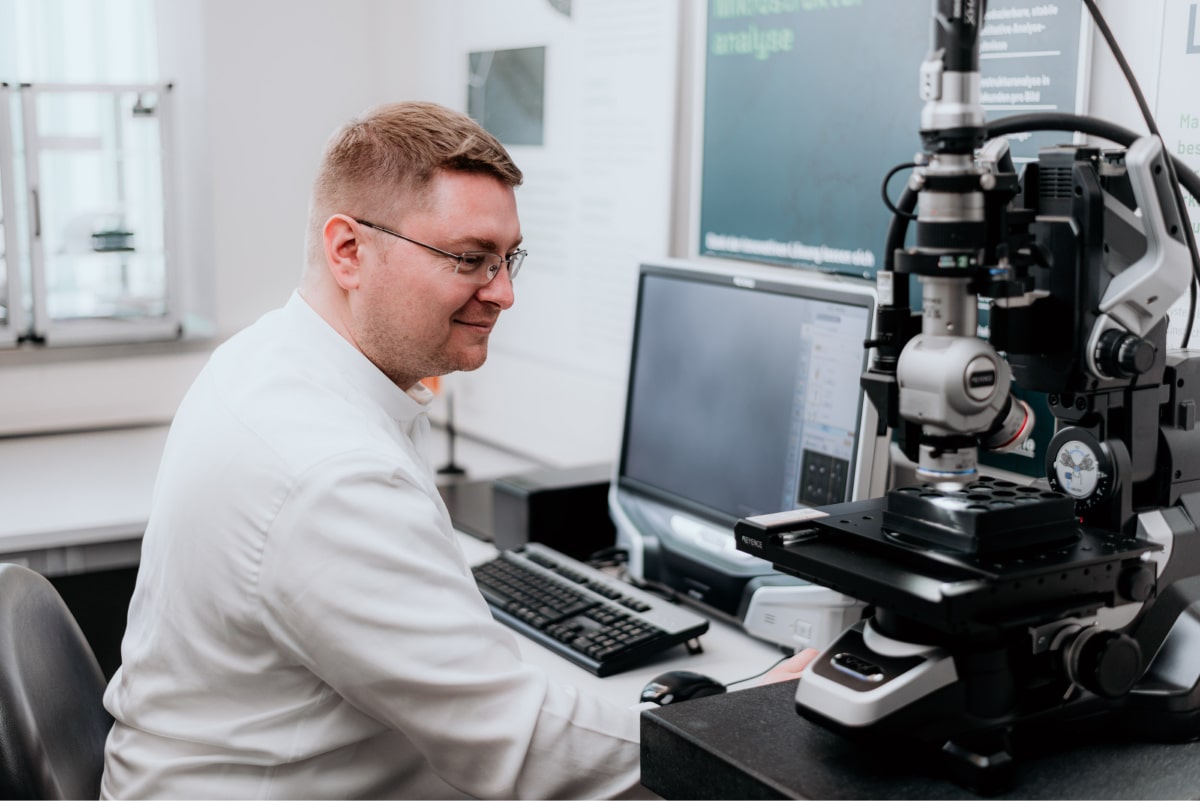10 reasons for in-house microstructure analyses - save costs, increase productivity
Inefficient product development and quality control through outsourced microstructure analyses? In-house analyses are faster, more independent and increase productivity.
In today's fast-moving and technology-driven industrial landscape, efficient processes in product development and quality control are crucial. With microstructure analyses, you can quickly check your processes. This makes them a key component for research and development as well as for quality control in laboratories.
Werden diese Analysen outgesourced, verliert man nicht nur wertvolle Zeit, sondern macht sich auch von den subjektiven Bewertungen externer Partner abhängig.
In diesem Blogbeitrag beleuchten wir zehn Gründe, warum die Implementierung von Inhouse-Mikrostrukturanalysen ein wesentlicher Schritt hin zur Gewinnung schneller, unabhängiger Ergebnisse sein kann.

1. On-site analyses for faster decision-making
The implementation of on-site analyses enables companies to check the quality and specifications of their materials in real time. This leads to faster feedback and enables immediate adjustments in the production process if necessary. Reducing the waiting time for analysis results is not only efficiency-enhancing, but also helps to reduce overall costs as potential problems can be identified and resolved more quickly. Overall, the ability to perform microstructure analyses on site leads to a more agile, responsive and cost-efficient production environment.
2. Detect errors at an early stage thanks to continuous analyses
By immediately identifying irregularities or deviations in the materials, companies can act proactively before these errors escalate into major problems. This is particularly important in order to avoid costly complaints and production downtime. Continuous in-house analyses therefore not only contribute to maintaining product quality, but are also a crucial tool in risk management and quality assurance. They enable companies to guarantee a high standard of quality while protecting the integrity of their products and brands.
3. Sofort verfügbare Analyseergebnisse für schnellere Prozessoptimierung
A decisive advantage of modern microstructure analysis is the immediate availability of the analysis results. This immediate feedback is invaluable for the rapid adaptation and optimisation of production processes. In an environment where every second counts, the direct evaluation of material data enables companies to react promptly to challenges and make necessary changes to production processes or material compositions. This not only leads to more efficient production, but also to improved product quality. The ability to quickly adapt processes based on up-to-date data is a key competitive advantage in the fast-moving world of manufacturing and materials science. It enables companies to remain agile, utilise resources effectively and ultimately strengthen their market position. Translated with www.DeepL.com/Translator (free version)
4. In-house analyses protect intellectual property
Conducting analyses in-house offers another, often overlooked advantage: the protection of intellectual property. In many industries, material compositions and processing techniques represent valuable and sensitive knowledge that is critical to a company's competitive advantage. When analyses are carried out outside the company, for example in external laboratories, there is always a certain risk that confidential information could be disclosed. In-house analyses, on the other hand, ensure that all data and knowledge about materials and manufacturing processes remain within the company. This not only protects intellectual property, but also the integrity of production secrets and the company's innovative strength. In an age where information is easily accessible and exchangeable, protecting intellectual property through in-house analyses is a crucial factor in maintaining market leadership and the ability to innovate.
5. Save cost long term
Although setting up an in-house laboratory for microstructure analyses initially represents a significant investment, the long-term financial benefits should not be underestimated. Companies that invest in in-house analytical capabilities can secure significant savings over time, particularly with regard to the costs normally incurred for external analytical services. These savings result from the reduction in fees for external laboratories, the elimination of transport costs for samples and the minimisation of waiting times often associated with external analyses. In addition, an in-house laboratory enables faster responsiveness and process optimisation, which indirectly leads to further cost savings by reducing waste and inefficient production processes. In the long term, investing in an in-house laboratory therefore leads to a significant reduction in overall expenditure and helps to increase operational efficiency and competitiveness.
6. On-demand analyses increase flexibility
Die Implementierung von Inhouse-Analysen in Produktions- und Forschungseinrichtungen bietet einen entscheidenden Vorteil: erhöhte Flexibilität. Mit der Fähigkeit, Analysen on-demand durchzuführen, sind Unternehmen nicht länger an die Zeitpläne und Verfügbarkeiten externer Dienstleister gebunden. Diese Unabhängigkeit ermöglicht es, Tests genau dann durchzuführen, wenn sie benötigt werden – sei es zur Überprüfung eines neu entwickelten Materials, zur schnellen Diagnose eines Produktionsproblems oder zur Durchführung regelmäßiger Qualitätskontrollen. Diese Flexibilität ist besonders wertvoll in dynamischen Produktionsumgebungen, wo schnelle Anpassungen und Entscheidungen oft kritisch für den Erfolg sind. Inhouse-Analysen erlauben es Unternehmen, agil und reaktionsfähig zu bleiben, indem sie die Kontrolle über ihre Test- und Analyseprozesse behalten und diese nahtlos in ihre täglichen Abläufe integrieren können, wie z.B. mit dem Analysetool von MiViA.
7. Data availability increases capacity for Innovation
Die unmittelbare Verfügbarkeit von Mikrostrukturdaten in Inhouse-Laboren ist ein entscheidender Faktor, der die Innovationskraft von Forschungs- und Entwicklungsabteilungen maßgeblich unterstützt. Wenn Teams direkten Zugriff auf detaillierte Materialdaten haben, können sie neue Ideen schneller entwickeln, testen und verfeinern. Diese Daten bieten wertvolle Einblicke in die Eigenschaften und das Verhalten von Materialien unter verschiedenen Bedingungen, was für die Entwicklung innovativer Produkte und Lösungen unerlässlich ist. Die Fähigkeit, auf diese Informationen schnell und ohne Verzögerungen zugreifen zu können, beschleunigt den gesamten Innovationsprozess. Teams können Hypothesen in Echtzeit überprüfen, Anpassungen vornehmen und iterativ arbeiten, was zu einer effizienteren und effektiveren Produktentwicklung führt. In einer Welt, in der der Wettbewerb zunehmend von der Schnelligkeit und Qualität der Innovationen abhängt, ist die sofortige Verfügbarkeit von Mikrostrukturdaten ein entscheidender Vorteil.
8. Personnel development contributes to the development of internal expertise
Operating an in-house laboratory for microstructure analyses is not only a benefit for a company's production and research processes, but also represents a valuable investment in personnel development. By working with advanced analytical methods and technologies on a daily basis, employees build up in-depth technical expertise. This ongoing hands-on experience fosters an understanding of materials science and analytical techniques, leading to an overall increase in technical expertise within the organisation. Employees who are directly involved in analysing and evaluating data develop a better understanding of the materials and processes they work with.
This in-depth knowledge not only contributes to individual professional development, but also strengthens the innovative power and problem-solving ability of the entire company. At a time when specialist knowledge and technical skills are becoming increasingly valuable, promoting internal expertise by running your own laboratory is a decisive step towards remaining competitive in the long term.
9. Use own material analyses for better customer service
The ability to carry out your own material analyses has a direct and positive impact on customer service. Companies that are able to respond quickly and accurately to customer enquiries with detailed material analyses offer significant added value. This responsiveness is particularly important in industries where material specifications and quality are critical. Customers appreciate the rapid provision of sound data and analyses that help them to make informed decisions. This level of service not only contributes to customer satisfaction, but also strengthens trust in the company.
In einer zunehmend wettbewerbsorientierten Geschäftswelt kann die Fähigkeit, umfassende und schnelle Analysen anzubieten, einen entscheidenden Unterschied ausmachen und langfristige Kundenbeziehungen fördern. Indem Unternehmen ihre Analysekapazitäten intern ausbauen, positionieren sie sich als verlässliche Partner, die über das notwendige Fachwissen verfügen, um ihren Kunden bestmöglichen Service zu bieten.
10. rapid adaptability brings long-term competitive advantages
In today's fast-moving business world, a company's ability to adapt quickly and efficiently to market changes is a decisive factor for long-term success and competitiveness. Companies that are agile and can react quickly to new trends, customer requirements or technological developments secure a significant advantage over the competition. This adaptability is particularly evident in areas such as materials science and production, where the rapid integration of new knowledge and technologies has a direct impact on product quality and innovation rates. Companies that have the internal capacity for rapid analysis and research are able to optimise their processes and products efficiently and thus react more quickly to market changes. This proactive attitude enables them not only to follow trends, but also to actively shape them and thus strengthen their market position. In the long term, it is these adaptable and responsive companies that are able to achieve sustainable growth and compete successfully in a constantly changing market environment.
Conclusion
The integration of in-house microstructure analyses is more than just an investment in equipment and technology; it is an investment in the future viability and competitiveness of your company.
By improving decision-making, quality control, innovation and customer relations, this strategic decision can lead to a significant increase in productivity and market position.
